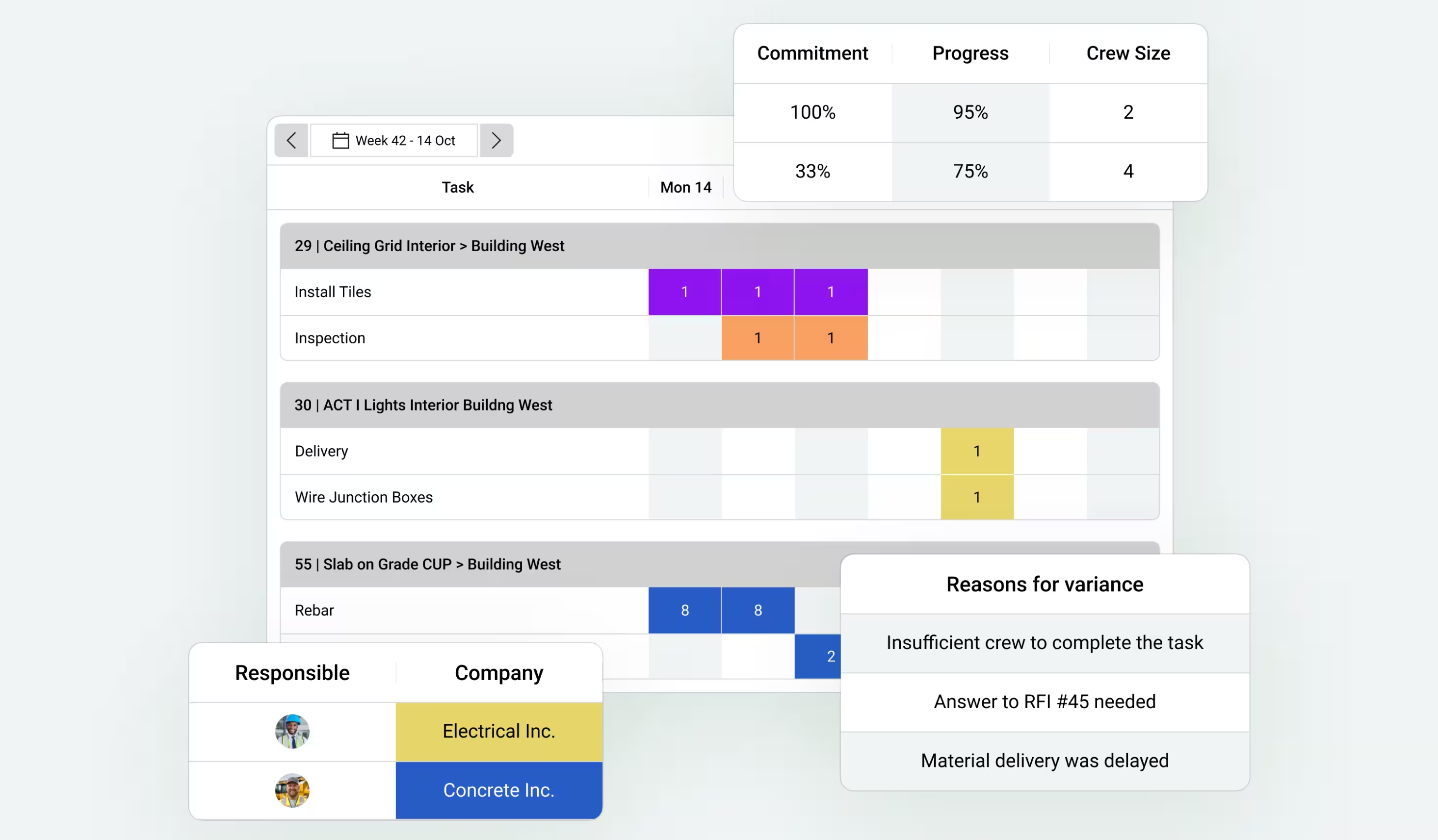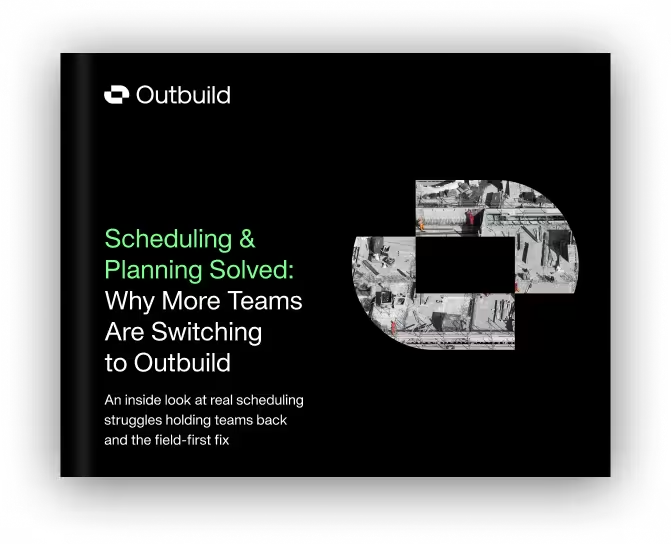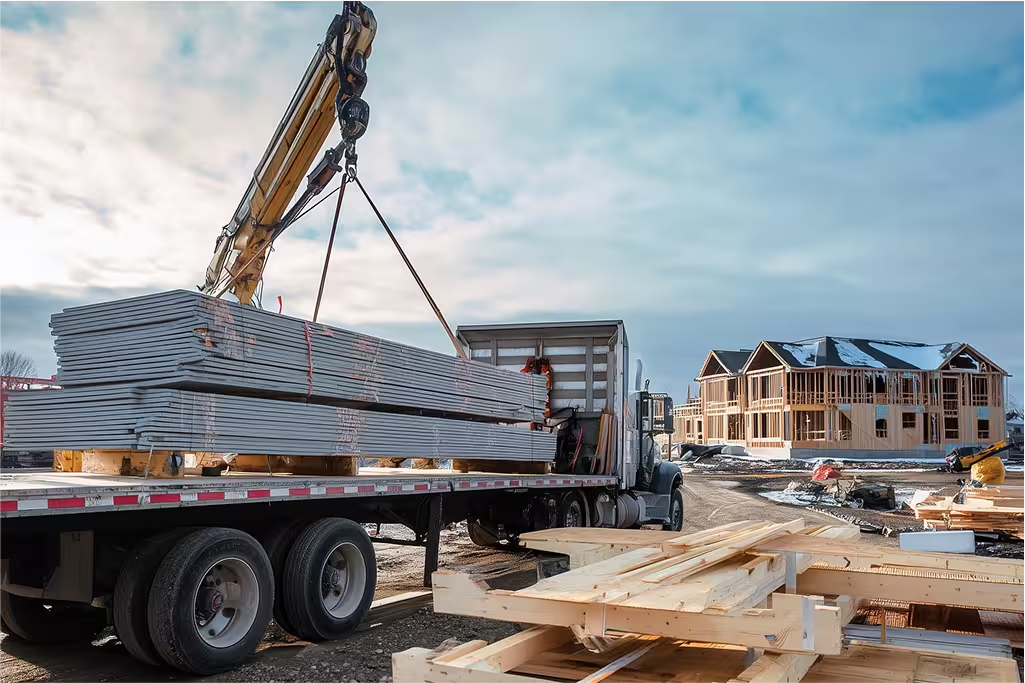Outbuild is online scheduling software to work together on connected project schedules and look-aheads, enabling everyone to move faster.
Key Takeaways
Table of contents
- What Is Construction Resource Management?
- Types of Construction Resources
- Top Construction Resource Management Software
- Best Practices for Construction Project Resource Management
- Construction Resource Management Examples
- Why Construction Resource Planning Matters
Picture this: a concrete crew is ready to pour, but the rebar hasn’t arrived. Hours slip away, costs rise, and frustration builds, all because of poor resource coordination.
Construction resource management is about keeping people, equipment, materials, and budgets working together. When you do it right, you save time and keep projects on track. This article explains what construction resource management means, the types of resources and how software can help.

Construction resource management is about planning and controlling resources. This includes labor, materials, tools, budget and partners. The goal is to ensure every project has what it needs, when it needs it.
In today’s current climate, this topic matters more than ever. Labor shortages, higher costs, and tighter schedules mean you can’t afford wasted effort.
A recent AGC report found that over 90% of contractors struggle to find skilled labor, and many projects fall behind because of it. Studies from McKinsey show that construction productivity has only grown 1% each year for the last twenty years. This is much lower than most other industries.
That’s why more builders are shifting from spreadsheets and phone calls to construction resource management software. These digital tools show exactly where people and equipment are, how busy they are, and when they’ll be free again. You can make decisions in minutes instead of hours with construction resource allocation technology.
Every construction manager deals with five main types of resource planning for construction projects. Each one plays a role in your project’s success.
1. People
Labor is the biggest variable. Managing people means knowing who’s available, what skills they have, and how long tasks will take.
This is a key part of human resource management in the construction industry. The resource manager in construction tracks workloads, certifications, and overtime.
2. Equipment
Cranes, lifts, excavators, and tools are expensive to own or rent. Good planning keeps them moving instead of sitting idle. In resource allocation in construction, you decide which job gets which machine and for how long. Even one unused lift for a week can cost thousands.
3. Materials
Materials like steel, concrete, or mechanical fixtures can slow everything down if they arrive late. Tracking delivery dates and linking them to your construction resource scheduling plan prevents costly standstills.
4. Money
Budgets connect everything. Resource planning in construction management ties together labor, equipment, and material costs. Knowing your cash flow helps avoid overstaffing or over-ordering.
5. External Partners
External partners also count as resources. Subcontractors, suppliers, and rental vendors can affect your schedule just as much as internal teams. Managing external resources is important because delays often start outside your control, so communication and visibility matter.

“50% of a project cost is typically labor. Since you and your competition pay about the same amount for materials and equipment—the only thing that separates you is how well you manage labor.” -Ben Schultz, Founder & CEO, LaborChart, a Procore Company
If you manage many projects or large teams, construction resource planning software helps you see the big picture. These tools show who’s working where, what’s available, and where the risks are.
Here are three major resource management software tools along with an equipment and asset tracking tool:
See how one platform, Bridgit, is transforming workforce planning:
Use a 3-Week Lookahead
Keep a 3-week lookahead tied to the master schedule. It helps teams plan labor, materials, and equipment ahead of time and spot issues early. When short-term plans stay linked to long-term goals, everyone stays aligned and work flows predictably.
Match Skills to Work
Don’t just assign people by name. Assign them by skill and certification. It makes backfilling easier when someone’s out and improves contractor resource planning.
Treat Equipment Like a Shared Fleet
Set rules for check-out and return dates. Track maintenance and downtime. Clear policies reduce lost time and double bookings.
Tie Materials to the Schedule
Use a simple tracker that links deliveries to upcoming tasks. Add a short buffer for long-lead items to avoid waiting on-site for optimal construction workload management.
Hold a Weekly Coordination Meeting
The weekly work plan keeps everyone aligned. It confirms who’s on each site, what deliveries are coming, and what could cause delays.
A weekly work plan makes sure all resources are ready and that responsibilities are clear. Tools like Outbuild make this handoff easy within the lookahead plan, keeping teams connected from the office to the field.
Forecast Costs and Labor Together
Compare planned hours against the budget. If costs spike, shift crews or move equipment to balance workload.

Curious to hear about a construction resource management plan example? Check out a few examples below:
Reducing Overtime at a Regional General Contractor
A general contractor with 140 field staff was running six jobs at once. Crews moved between projects with little notice and average overtime was 11 hours per person per week.
After switching to construction resource management software, they leveraged lookahead plans and matched skills to each task.
Within three months, overtime dropped 36%, and rental costs fell 18% due to better technology.
Civil Contractor Managing Heavy Equipment
A self-perform civil firm struggled to coordinate six dozers across multiple sites. Jobs often fought for the same operators.
After adopting construction resource planning software, they set up dispatch alerts and a shared equipment calendar. Idle machine time dropped 22%, saving around 260 rental hours per month.
Residential Builder Aligning Subs and Deliveries
A homebuilder often had framers waiting on delayed windows. They started using construction resource scheduling software to connect deliveries with crew availability.
Delayed starts dropped 70%, and project costs fell about 3.5% for those phases.
Every hour and every gallon of fuel counts. Resource management in construction isn’t just about tracking, it’s about control and predictability.
With the right tools and habits, teams hit deadlines more consistently and waste less money. Studies show that companies using digital resource management can cut project delays by 20%. They can also reduce overtime by 30 to 40%.
In a competitive market, that margin can decide who wins the next bid. This is the importance of resource management in construction projects. It’s how you balance crews, machines, and materials so work flows smoothly.
Begin with a clear weekly plan. Keep a view of the next three weeks through construction scheduling and planning software like Outbuild. Use construction resource management software. Spreadsheets alone are not enough.
Simple consistency beats complex systems every time. Build your process, train your team, and keep improving. Your projects will thank you for it.
If you manage many projects or large teams, construction resource planning software helps you see the big picture. These tools show who’s working where, what’s available, and where the risks are.
Here are three major resource management software tools along with an equipment and asset tracking tool:
See how one platform, Bridgit, is transforming workforce planning:
Use a 3-Week Lookahead
Keep a 3-week lookahead tied to the master schedule. It helps teams plan labor, materials, and equipment ahead of time and spot issues early. When short-term plans stay linked to long-term goals, everyone stays aligned and work flows predictably.
Match Skills to Work
Don’t just assign people by name. Assign them by skill and certification. It makes backfilling easier when someone’s out and improves contractor resource planning.
Treat Equipment Like a Shared Fleet
Set rules for check-out and return dates. Track maintenance and downtime. Clear policies reduce lost time and double bookings.
Tie Materials to the Schedule
Use a simple tracker that links deliveries to upcoming tasks. Add a short buffer for long-lead items to avoid waiting on-site for optimal construction workload management.
Hold a Weekly Coordination Meeting
The weekly work plan keeps everyone aligned. It confirms who’s on each site, what deliveries are coming, and what could cause delays.
A weekly work plan makes sure all resources are ready and that responsibilities are clear. Tools like Outbuild make this handoff easy within the lookahead plan, keeping teams connected from the office to the field.
Forecast Costs and Labor Together
Compare planned hours against the budget. If costs spike, shift crews or move equipment to balance workload.

Curious to hear about a construction resource management plan example? Check out a few examples below:
Reducing Overtime at a Regional General Contractor
A general contractor with 140 field staff was running six jobs at once. Crews moved between projects with little notice and average overtime was 11 hours per person per week.
After switching to construction resource management software, they leveraged lookahead plans and matched skills to each task.
Within three months, overtime dropped 36%, and rental costs fell 18% due to better technology.
Civil Contractor Managing Heavy Equipment
A self-perform civil firm struggled to coordinate six dozers across multiple sites. Jobs often fought for the same operators.
After adopting construction resource planning software, they set up dispatch alerts and a shared equipment calendar. Idle machine time dropped 22%, saving around 260 rental hours per month.
Residential Builder Aligning Subs and Deliveries
A homebuilder often had framers waiting on delayed windows. They started using construction resource scheduling software to connect deliveries with crew availability.
Delayed starts dropped 70%, and project costs fell about 3.5% for those phases.
Every hour and every gallon of fuel counts. Resource management in construction isn’t just about tracking, it’s about control and predictability.
With the right tools and habits, teams hit deadlines more consistently and waste less money. Studies show that companies using digital resource management can cut project delays by 20%. They can also reduce overtime by 30 to 40%.
In a competitive market, that margin can decide who wins the next bid. This is the importance of resource management in construction projects. It’s how you balance crews, machines, and materials so work flows smoothly.
Begin with a clear weekly plan. Keep a view of the next three weeks through construction scheduling and planning software like Outbuild. Use construction resource management software. Spreadsheets alone are not enough.
Simple consistency beats complex systems every time. Build your process, train your team, and keep improving. Your projects will thank you for it.
Frequently Asked Questions
Start small. Use one shared spreadsheet or lookahead calendar to log who’s on each site and what equipment they use. Once that is consistent, switch to a digital tool for construction resource planning or scheduling. Make sure it works with your main project management system.
A resource manager in construction ensures the right people, equipment, and materials are available when needed. They plan workloads, track availability, and adjust schedules to avoid downtime or conflicts between projects. Their job keeps crews productive, budgets balanced, and projects running smoothly from start to finish.
A construction manager handles many types of resources like people, materials, equipment, money, and time. They organize teams and subcontractors. They ensure materials arrive on time. They track budgets and manage schedules to keep the project on track.
Managing outside resources is important in construction. A project's success relies heavily on people and materials from outside the company. Subcontractors, equipment rentals, and material suppliers all play a major role in keeping the schedule and budget on track.
Related Articles
Ready to see Outbuild?
Join hundreds of contractors from 10+ countries that are saving money by scheduling better









